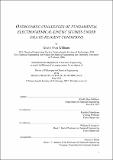| dc.description.abstract | Electrochemical reactions show promise for decarbonizing the chemical industry through distributed, local chemical synthesis; replacement of hazardous, atom-inefficient, and emissions-heavy precursors and processes with benign reagents and electrical potential; the storage of intermittent renewable energy in chemical bonds; and the direct conversion of CO2 into value-added chemicals. Before electrochemical technologies can be deployed, however, they must go through many stages of development. Different electrochemistries have different needs prior to deployment. In this thesis, we focus on lab-scale, fundamental kinetic studies of select electrochemistries – particularly those chemistries for which dilution or mixing phenomena are of practical concern.
We first discuss electrochemical CO2 reduction – a chemistry that is very well studied in the lab environment, but has yet to reach deployment stage. In particular, we address the questions: what happens if we do not have access to a pure CO2 gas feed? Is electrochemical CO2 reduction tolerant to common CO2 impurities such as N2 and O2? Through mechanistic study, we demonstrate that neither the rate nor the mechanism of CO2 reduction is affected by the presence of O2, but that the cathodic co-reduction of O2 at relevant potentials represents a parasitic current – an energetic trade-off for tolerance to feed impurity which should be considered in technoeconomic analyses of CO2 reduction systems.
Next, we consider mixtures not in the gas phase but in the liquid phase: blended aqueous-nonaqueous electrolytes. Such mixtures are often used to bring organic substrates into contact with water as a co-reactant, for example in O-atom transfer chemistries. We describe and measure complexities of working in such systems, such as solvent components that behave nonideally and ill-defined potential scales. We report the first measurement of the water dependence of nonaqueous alkaline hydrogen evolution, accounting for such nonidealities. In doing so, we propose molecular explanations for water’s nonideal behavior and hypothesize many roles water can play in blended electrolytes. Finally, we use such a blended electrolyte to develop an approach to benzylic C-H oxidation for the production of commodity chemicals.
We hope this work represents a useful step toward the understanding and deployment of these relevant electrochemical systems. | |
